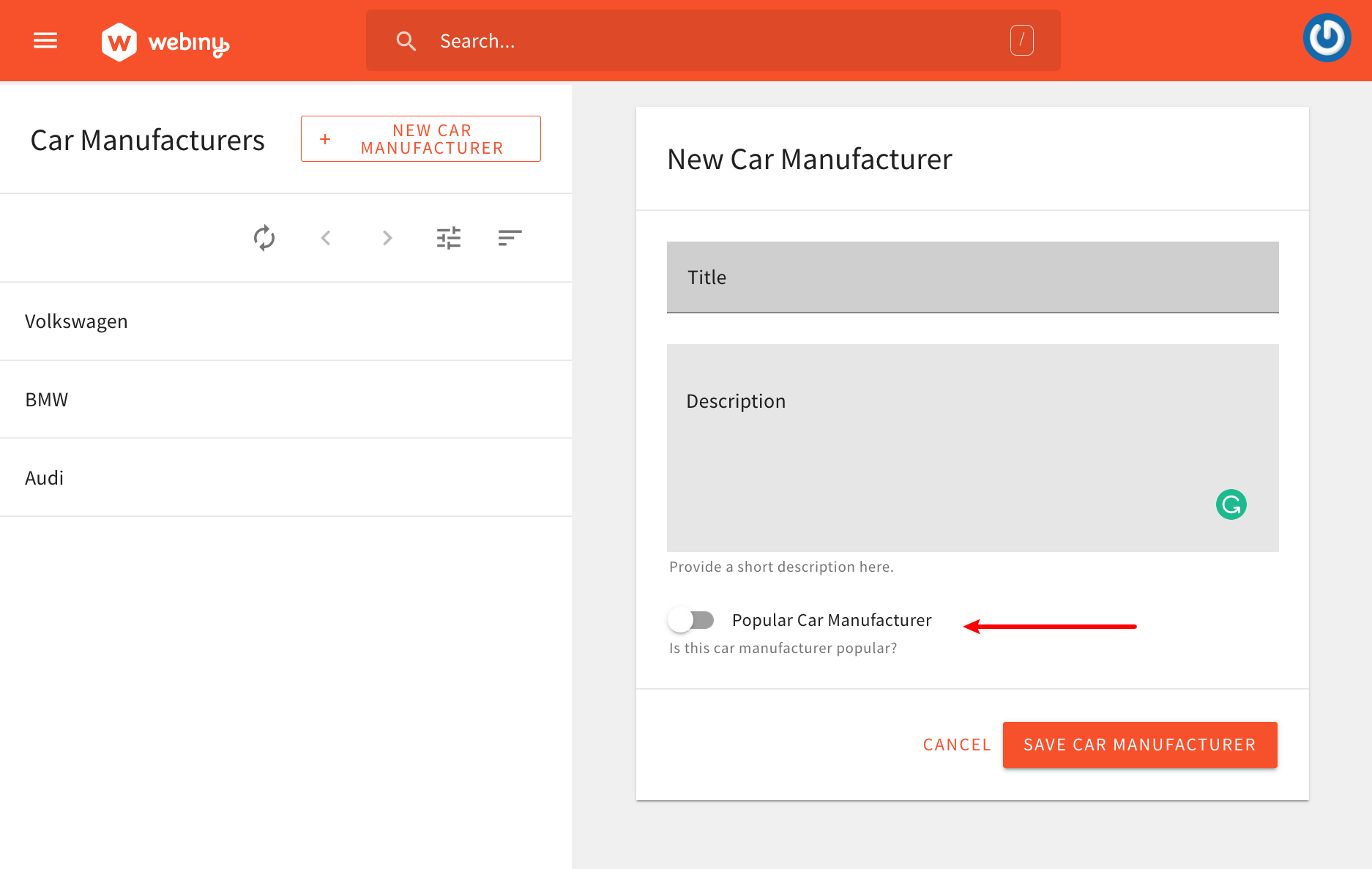Extending Entities
Learn how to continue developing on top of the generated application code, by extending the initially generated entity with new attributes.
- how to continue developing on top of the generated application code
- GraphQL API: how to extend the initially created entity with new attributes
- Admin Area: how to extend the initially created form with new form fields
In order to follow this tutorial, you must use Webiny version 5.9.0 or greater.
Overview
Initially, the CarManufacturer 
title 
description 
Let’s see how we can add the new isPopular boolean attribute to the CarManufacturer 
Switch 
GraphQL API
Starting from the GraphQL API, let’s open our CarManufacturer 
(...)
export default new Entity<CarManufacturerEntity>({
table,
name: "CarManufacturers",
timestamps: false,
attributes: {
PK: { partitionKey: true },
SK: { sortKey: true },
id: { type: "string" },
title: { type: "string" },
description: { type: "string" },
isPopular: { type: "boolean" },
createdOn: { type: "string" },
savedOn: { type: "string" },
createdBy: { type: "map" },
webinyVersion: { type: "string" }
}
});Notice how we’re passing the CarManufacturerEntity 
Entity class. Since the interface is essentially listing all attributes that our entity consists of, let’s update it as well:
(...)
export interface CarManufacturerEntity {
PK: string;
SK: string;
id: string;
title: string;
description?: string;
isPopular?: boolean;
createdOn: string;
savedOn: string;
createdBy: Pick<SecurityIdentity, "id" | "displayName" | "type">;
webinyVersion: string;
}
(...)Finally, let’s update our CarManufacturer GraphQL types in our schema, located in the typeDefs.ts 
export default /* GraphQL */ `
type CarManufacturer {
id: ID!
title: String!
description: String
isPopular: Boolean
createdOn: DateTime!
savedOn: DateTime!
createdBy: CarManufacturerCreatedBy
}
input CarManufacturerCreateInput {
title: String!
description: String
isPopular: Boolean
}
input CarManufacturerUpdateInput {
title: String
description: String
isPopular: Boolean
}
(...)
`;webiny watch commands, mentioned in the previous section, the performed application code changes should be automatically rebuilt and redeployed into the cloud.Once we’ve done all of the above shown changes, we can switch to our Admin Area application, and continue by updating the Car Manufacturers form.
Admin Area Application
In the CarManufacturersForm 
Switch 
(...)
// We've imported the Switch component from the `@webiny/ui` package.
import { Switch } from "@webiny/ui/Switch";
(...)
return (
<Form data={carManufacturer} onSubmit={onSubmit}>
{({ data, form, Bind }) => (
<SimpleForm>
{loading && <CircularProgress />}
<SimpleFormHeader title={data.title || "New Car Manufacturer"} />
<SimpleFormContent>
<Grid>
(...)
<Cell span={12}>
<Bind
name="isPopular"
>
<Switch
label={"Popular Car Manufacturer"}
description={"Is this car manufacturer popular?"}
/>
</Bind>
</Cell>
</Grid>
</SimpleFormContent>
<SimpleFormFooter>
<ButtonDefault onClick={cancelEditing}>Cancel</ButtonDefault>
<ButtonPrimary onClick={form.submit}>Save Car Manufacturer</ButtonPrimary>
</SimpleFormFooter>
</SimpleForm>
)}
</Form>
);Once we’ve updated the CarManufacturersForm 
 Updated Car Manufacturers Form
Updated Car Manufacturers FormFinally, we need to add the isPopular field to all relevant GraphQL query and mutation operations. This ensures that we’re both sending and receiving the isPopular value while interacting with the GraphQL API.
Adding the isPopular field can be easily done by updating the CAR_MANUFACTURER_FIELDS_FRAGMENT 
graphql.ts 
import gql from "graphql-tag";
export const CAR_MANUFACTURER_FIELDS = /* GraphQL */ `
fragment CarManufacturerFields on CarManufacturer {
id
title
description
isPopular
createdOn
savedOn
createdBy
}
`;
(...)With this final change in place, we should be able to edit the isPopular attribute for each car manufacturer entry. To test this, we can simply open an existing entry, try marking it as popular, and submitting the form. If everything was done correctly, the form submission should be successful.
 Updated Car Manufacturers Form
Updated Car Manufacturers FormFAQ
I See DynamoDB Toolbox Is Being Used for Interacting With Amazon DynamoDB. Can I Use a Different Library?
On the GraphQL API side, you might have noticed we’re using DynamoDB Toolbox 

Can I Bring My Own NPM Libraries?
You are free to bring your own preferred NPM libraries.
How Can I Perform Data Validation?
For data validation in general, we recommend you check out the @webiny/validation 